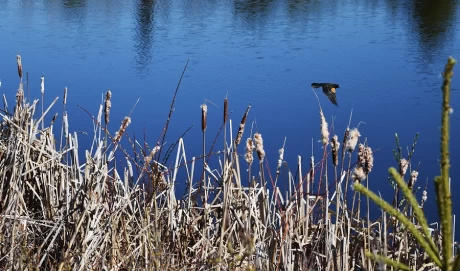PROJECTS
Projects
Wastewater Becomes a Wetland Wonder - Western Acres, Prince George, BC

Client: City of Prince George
Location: Prince George, BC
Finding Sustainable Wastewater Solutions in Partnership with the City of Prince George
Flushing the toilet can lead to beautiful things. That’s the case for people who live in the Western Acres subdivision, just east of Beaverly. Sewage from residents in Western Acres is treated through a lagoon system just off Muralt Road that also serves as a wetland area, rife with birds, beavers, deer, moose, and other wildlife.
Western Acres is an engineered wetland, meaning it was adapted to accommodate the wastewater system. However, the creek and wetland naturally existed beforehand. The lagoon provides excellent wildlife habitat for several species of birds, including geese and ducks, amphibians, muskrats and beavers. Wetlands are also important for ungulate species such as deer and moose because of the vegetation, and provides habitat for coyotes, foxes, and small mammals such as voles and squirrels.
“Lagoons are an example of how urban development can work with the natural environment,” said Byrne. “They act as a natural filtration device that absorb and filter sediments, pollutants, and excess nutrients. They also recharge groundwater, maintain stream flows, control runoff, store flood waters, reduce erosion, stabilize shorelines, and help to regulate atmospheric gases and climate cycles.”
How Western Acres Works
Primary treatment occurs upstream in the three-celled Western Acres Lagoon. Blackwater (water from toilets) from Western Acres goes through the three cells where it is broken down by the sun, wind, algae, and bacteria. Through the three-cell system, the blackwater is converted into cleaner greywater, as organic materials are broken down and sink to the base of the lagoon to decompose. The greywater is then discharged to Hiller Creek once it meets the proper conditions for coliforms (bacteria), total suspended solids (TSS), biochemical oxygen demand (BOD), and excess nutrients where it then moves to secondary treatment in the Western Acres Wetlands.
Secondary treatment involves “polishing” of the greywater by further reducing TSS and BOD through filtration through the wetland vegetation and natural mixing in the wetland. Microorganisms that live in the wetlands plants and soils remove any biodegradable material from the water through decomposition, and aquatic plants (such as cattails) absorb excess nutrients and carbon dioxide and produce oxygen. Once the water is fully treated in the wetland it returns to Hiller Creek. Discharge only occurs once water quality guidelines and creek flow conditions are met.
The city has a permit with the Ministry of Environment to discharge into Hiller Creek. Effluent water quality and lagoon levels are monitored, as are the integrity of the berms for signs of erosion or rodent damage. Lagoons are inspected by staff every day except holidays. Grounds maintenance is performed as needed and weed and rodent control is in place.
Reprinted with permission from https://pgdailynews.ca
